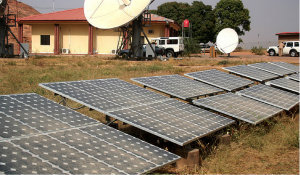Some critics of policies to reduce the use of electricity and conventional fuels argue that the use of green energy is a privilege only afforded to the already wealthy, or to already developed countries. Yet, energy that relies on naturally-available resources like the sun has an inherently equalizing quality: It is equally available to everyone. Lagos, Mumbai, Dhaka and Caracas offer four examples of innovative projects to harness solar energy, or even to control solar heat, to provide low-cost solutions to longstanding social or environmental challenges.
 Harvesting energy from natural sources to which all of Lagos' residents have access has become increasingly important, as conventional energy sources are neither affordable nor available to all. The city of Lagos is now taking advantage of solar energy to provide power for services such as health care and education. The city has seven completed Maternal and Child Centers with 24-hour Primary Health Care services. Whereas in the past these 24-hour services would have been disrupted by power cuts or forced to rely on heavily polluting diesel-powered generators, the new infrastructure has been built to run on solar energy. By the end of June 2015, 172 schools across Lagos State will also be powered by solar, and the state will fund 2,500 rechargeable solar lamps for distribution to school children. Power cuts will no longer have the same devastating effects on critical healthcare services and children's ability to study.
Harvesting energy from natural sources to which all of Lagos' residents have access has become increasingly important, as conventional energy sources are neither affordable nor available to all. The city of Lagos is now taking advantage of solar energy to provide power for services such as health care and education. The city has seven completed Maternal and Child Centers with 24-hour Primary Health Care services. Whereas in the past these 24-hour services would have been disrupted by power cuts or forced to rely on heavily polluting diesel-powered generators, the new infrastructure has been built to run on solar energy. By the end of June 2015, 172 schools across Lagos State will also be powered by solar, and the state will fund 2,500 rechargeable solar lamps for distribution to school children. Power cuts will no longer have the same devastating effects on critical healthcare services and children's ability to study.
A recent study found that there is just one toilet for every 5,000 people in Mumbai's informal communities. Further, research found that 58 percent of the toilets that do exist have no electricity and 78 percent have no water. Triratna Prerna Mandal, an NGO, began using solar power when electricity and water bills became too expensive to run its toilets. To use the NGO's solar-powered toilets, nearby residents have to pay as little as US$2.40 per year, compared to US$90 per month for electricity for regular toilets. In addition to lowering expenses, the solar panels have also increased safety for women by providing reliable lighting around the clock. Similarly, the Gates Foundation debuted a self-contained, waterless toilet that also runs on toilet power, converting human waste to the charcoal biochar. Solar power may hold the solutions for addressing the city's toilet crisis.
In Dhaka, the demand for electricity is greater than capacity, so authorities divert all generated electricity to select parts of the city while keeping other parts in the dark for several hours at a time. Informal settlements, where the crowded layout of buildings restricts sunlight, are severely affected by these power cuts. Drawing inspiration from the Brazilian innovator Alfredo Moser who created the "Liter of Light," Dhaka-based research organization started the Botol Bati project in 2012 to install solar power bottle lights in households. According to the organization, 83 percent of residents in the informal community of Mirpur now use bottle lights and only 16 percent remain dependent on electricity. Residents using bottle lights have lower electricity bills and are able to continue work through power cuts. A modification of the bottle light in which the bottle is connected to a solar panel and battery provides power even during the night.
 In Caracas, although the weather is tropical and residents often use rooftops as outdoor terraces with potted plants, the idea of covering the whole roof surface with soil and plants as a strategy to reduce heat inside buildings is still just beginning to take root. A new public library was recently the site of a pilot green roof project, coordinated by the municipality and funded by local garbage company Sateca. The roof garden has reduced the library's interior temperature by between five and eight degrees Celsius, in turn reducing the use and cost of air conditioning. Furthermore, the roof traps 75 percent of rainwater that falls, which later evaporates instead of flowing to the overtaxed public drainage systems. It also reduces the temperature in the city by avoiding heat islands -- a serious problem during the dry season -- and provides a roof terrace for leisure and recreation.
In Caracas, although the weather is tropical and residents often use rooftops as outdoor terraces with potted plants, the idea of covering the whole roof surface with soil and plants as a strategy to reduce heat inside buildings is still just beginning to take root. A new public library was recently the site of a pilot green roof project, coordinated by the municipality and funded by local garbage company Sateca. The roof garden has reduced the library's interior temperature by between five and eight degrees Celsius, in turn reducing the use and cost of air conditioning. Furthermore, the roof traps 75 percent of rainwater that falls, which later evaporates instead of flowing to the overtaxed public drainage systems. It also reduces the temperature in the city by avoiding heat islands -- a serious problem during the dry season -- and provides a roof terrace for leisure and recreation.
Check out more of the discussion on light, heat, and energy powering poor communities on URB.im and contribute your thoughts.
Photo credits: Jeremy Weate; El Universal